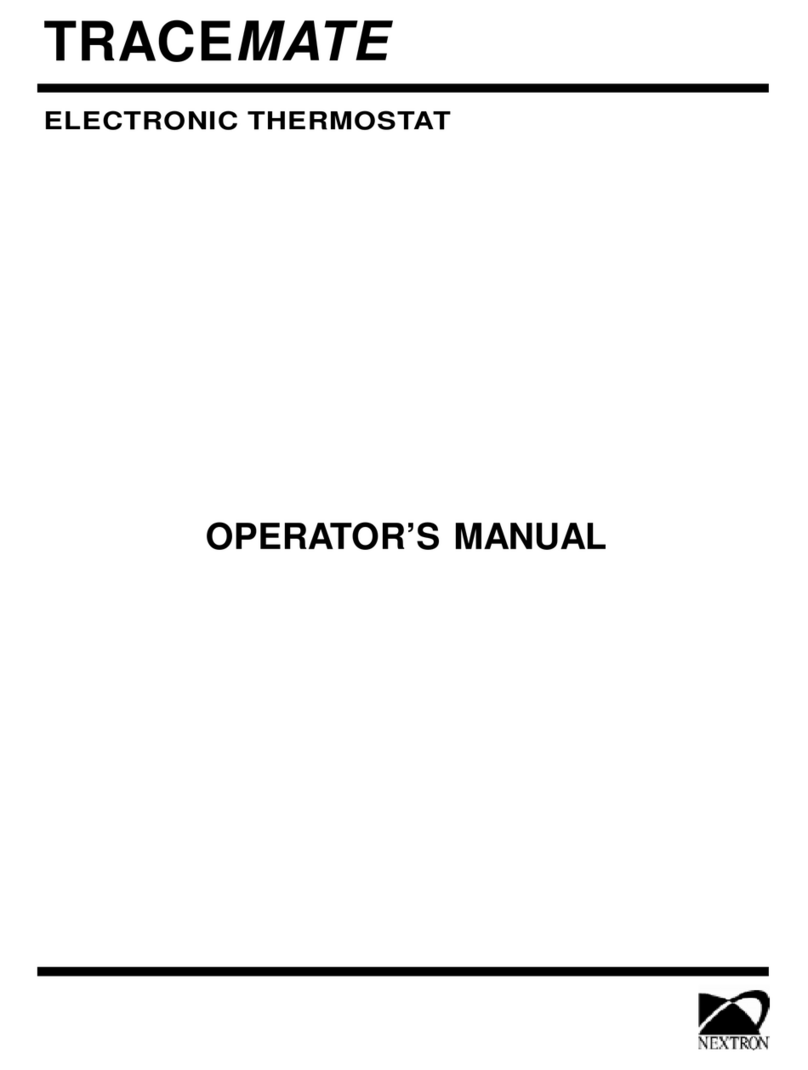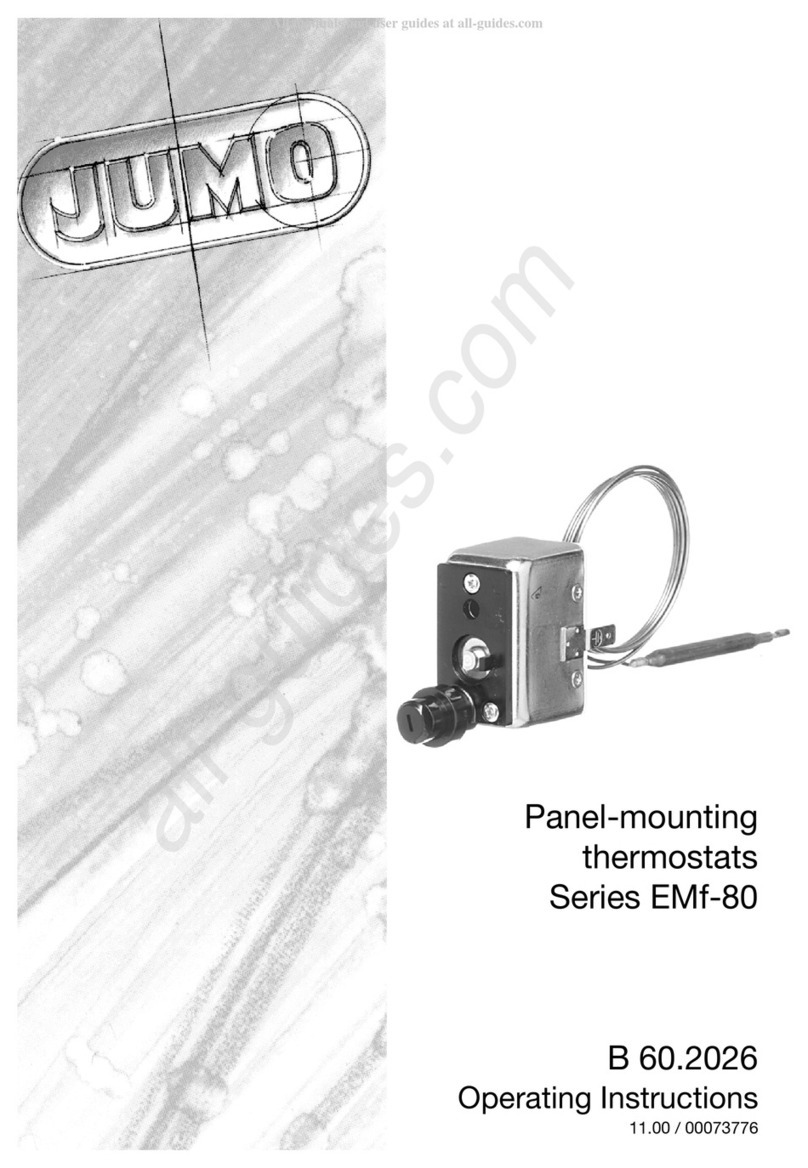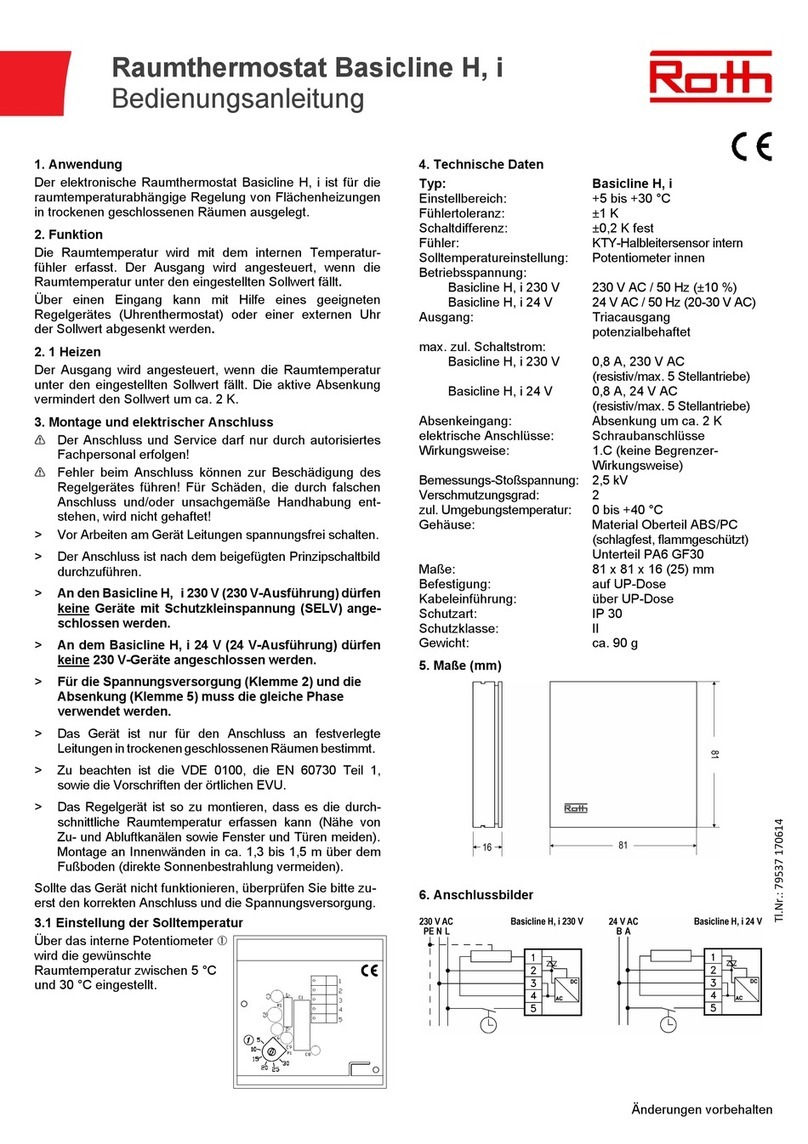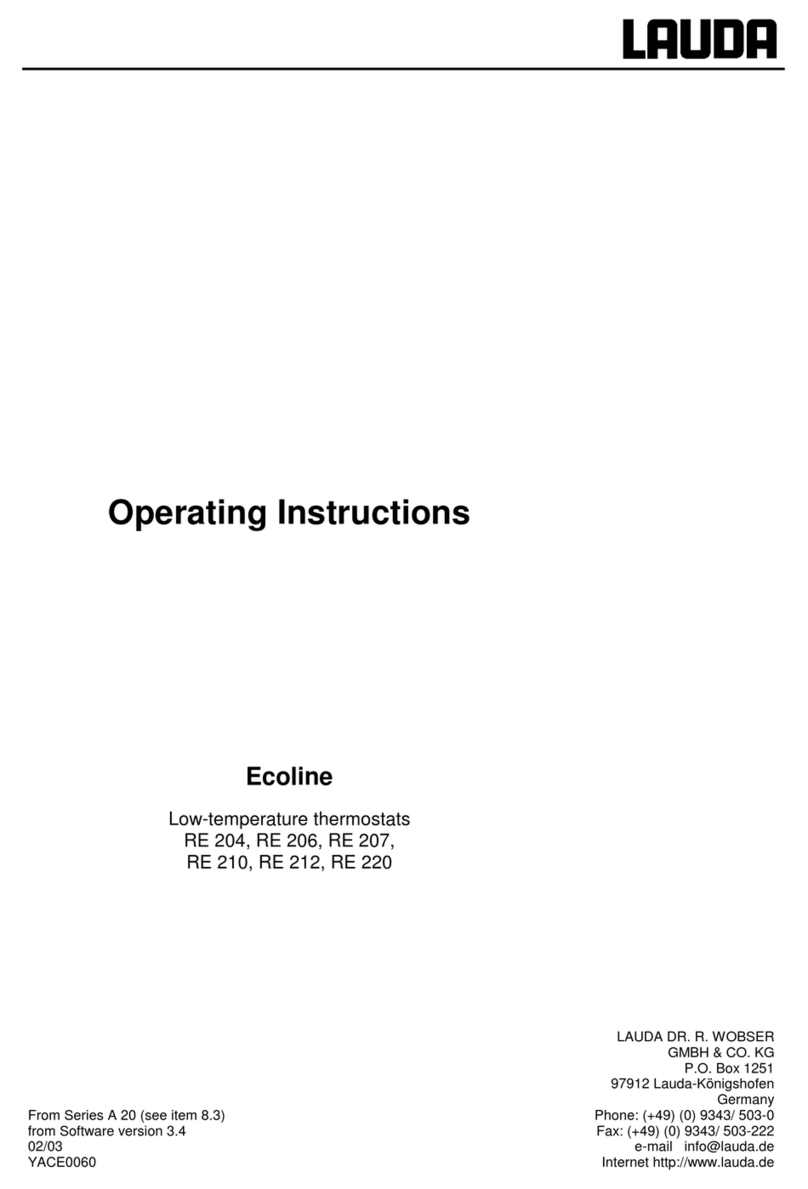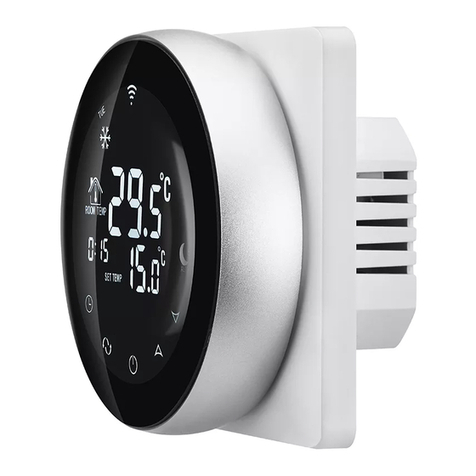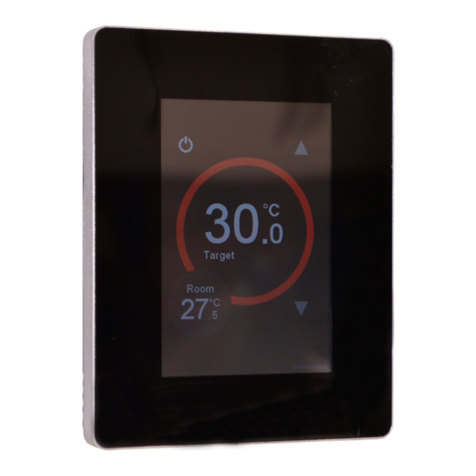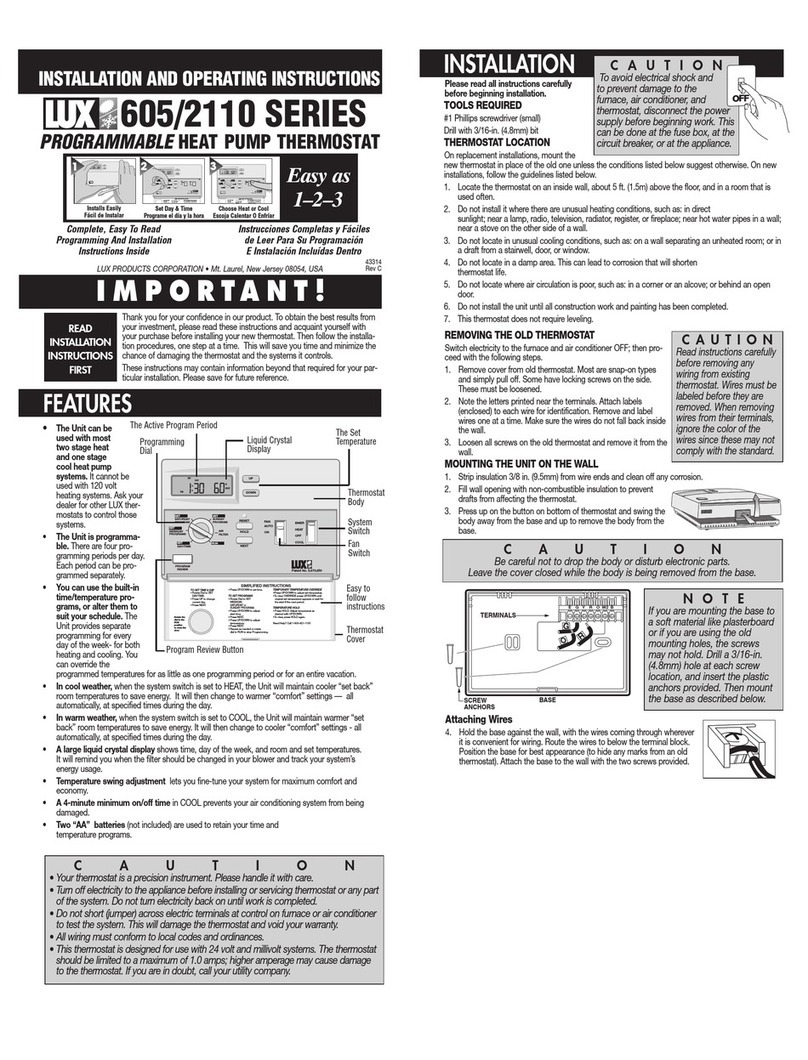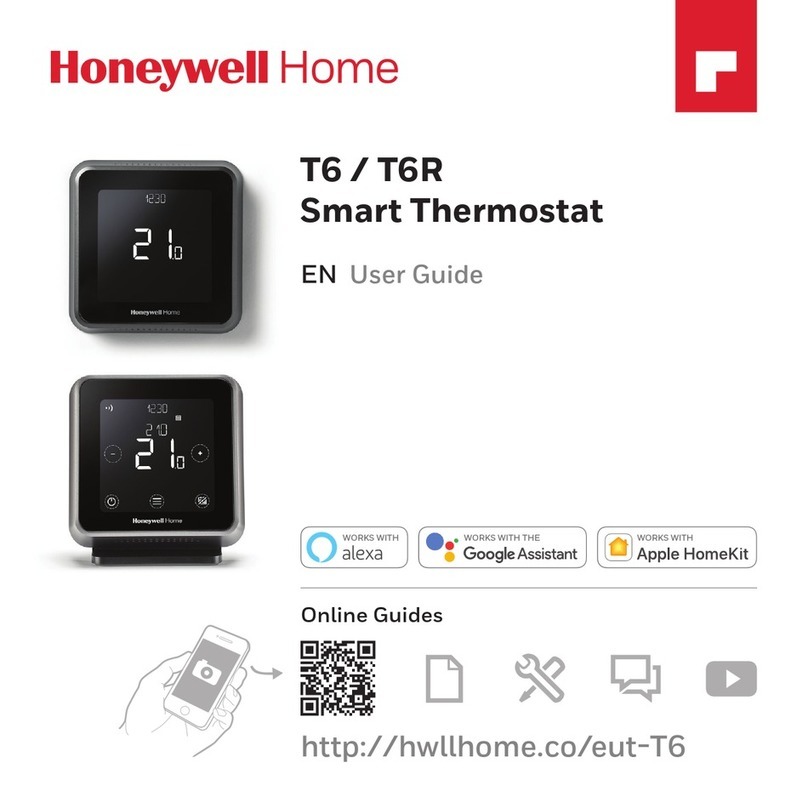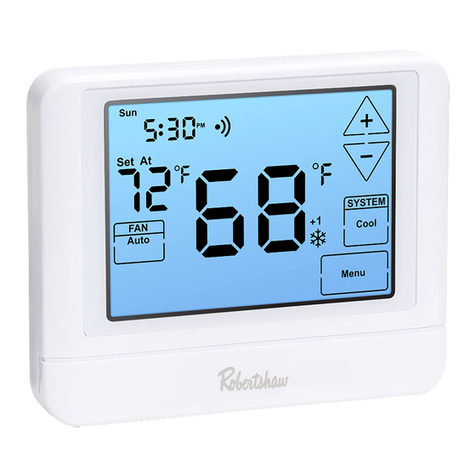Nextron TRACEMATE II-CTR User manual

TRACE
MATE II-CTR
OPERATOR’S MANUAL
ELECTRONIC THERMOSTAT

TRACE
MATE II-CTR
Contents
1 Product Overview .................................................................................................................... 1.1
Introduction........................................................................................................................................................................ 1.1
Features and Benefits....................................................................................................................................................... 1.1
Conventions....................................................................................................................................................................... 1.1
Specifications .................................................................................................................................................................... 1.2
2 Installation................................................................................................................................ 2.1
Unpacking the Controller .................................................................................................................................................. 2.1
Control Module .................................................................................................................................................................. 2.1
Mounting the Controller .................................................................................................................................................... 2.3
Wire Sizing ........................................................................................................................................................................ 2.3
Conduit and Cabling ......................................................................................................................................................... 2.3
Power Wiring ..................................................................................................................................................................... 2.3
Heater Wiring .................................................................................................................................................................... 2.3
Ground Connection ........................................................................................................................................................... 2.3
RTD Sensor Wiring ........................................................................................................................................................... 2.3
Alarm Wiring ...................................................................................................................................................................... 2.4
3 Applications ............................................................................................................................. 3.1
Mechanical Thermostat Replacement ............................................................................................................................. 3.1
Remote Zone Alarm .......................................................................................................................................................... 3.1
Alarm Annunciator............................................................................................................................................................. 3.1
Local Alarm........................................................................................................................................................................ 3.1
Switching Requirements ................................................................................................................................................... 3.1
4 Operation.................................................................................................................................. 4.1
Alarms................................................................................................................................................................................ 4.1
Alarm Contacts .................................................................................................................................................................. 4.1
Alarm Messages................................................................................................................................................................ 4.1
Alarm Indicators ................................................................................................................................................................ 4.1
Status Indicators................................................................................................................................................................ 4.1
Alarm Reset ....................................................................................................................................................................... 4.2
Heater Setpoint and Alarm Setpoints.............................................................................................................................. 4.2
5 Testing ...................................................................................................................................... 5.1
Troubleshooting/System Integrity..................................................................................................................................... 5.1
Calibration ......................................................................................................................................................................... 5.1
Ground Fault Testing......................................................................................................................................................... 5.2
Repairs............................................................................................................................................................................... 5.2
Warranty ........................................................................................................................Back Cover

TRACE
MATE II-CTR
1.1
Product Overview
Introduction
TheTraceMate II-CTR solid state heat tracing control is
an electronicthermostatdesigned tomaintain two
seperated heaters at their respectivedesired setpoint
temperatures. It issuitablefor usewith mineral-insulated,
self-regulating or constant-wattage cablein applications
such as freeze protection, process control and instrument
tracing. TheTraceMate II-CTR isintended for indoor or
outdoor installation in ordinaryor class 1, division 2
hazardouslocations.
TraceMate II-CTR offers manyadvantages over other
heattracing controlschemes, which generallyuse some
combination ofmechanical thermostats, custom-built
panels or programmable controls to provide control,
monitoring and alarm functions. Wiring costs are mini-
mized bymounting the control in close proximityto the
heat tracing cableand pipe.ANEMA4 enclosureand
wide temperature range electronic components are used to
make mounting possible in most locations. Temperature
sensing ofeach heater is achieved bymounting a 100 ohm
platinum (DIN 43760) RTD sensor on the pipe. Heater
current is controlled bya solid state switch rated 30A.
Thetemperature setpoint and other setpoints are digital
for fast non-ambiguous setting over a widerange. Instant
system information such as pipe temperatures, heater
currents,groundfault currents,andheater on/off&alarm
status can be seen on the LCD displaymounted on the
door ofthe enclosure. Maximum system reliabilityis
obtained from a comprehensive alarm package which
includes LCD displaymessages and LED indicators for
quickfault identification and a ground faulttrip to
minimizefire hazards.
Bycombining the control, system monitoring and testing
requirements ofa heat trace control system into a general
purpose control, the TraceMate II-CTR makes it possible
to significantlyupgrade systems at low installed cost. In
addition, it is very flexible in its application to adapt to
specific user requirements.
Conventions
The following conventions are used in this manual:
Features and Benefits
Requirements TraceMate II-CRT Features
Temperature
Control *
*
*
*
0-511°C/0-511°F setpoint
Non-ambiguous, digital temperature
setpoint
100 ohm platinum RTD sensor
3-wire, lead resistance compensation
System Fault
Alarms *
*
*
*
*
*
Breaker left off or tripped
Heater continuity or low current
Ground fault trip
Low temperature
Hightemperature
Broken sensor
EarlyWarning *
*
*
Tracecheck exercises dormant
systems every 24 hours for early
warning to prevent shutdowns
LCD display messages and LED
indicators show cause of alarms
Separate fail-safe local and remote
alarms
Remote
Monitoring
*
*
*
*
DC or AC alarm output for PLC or
remote alarm indication
Form C alarm dry contact output
alarm indication
RS232 communication port
16X1 LCD display
Hazardous/
Ordinary Area
Mounting
*
*
*
*
CSA approved for ordinary or Class
1, Division 2, Grps A,B,C,D
hazardous area
-40° to +50°C operating range
30 amps @120/208~240/277VAC
rating
Weatherproof, Nema-4 enclosure
Easy retrofit replacement for
mechanicalthermostat
Low Installed
Cost *
*
*
*
Competitively priced
Self contained, no control panel to
build
Ground fault trip eliminates expensive
ground fault circuit breaker
Standard model simplifies spare
parts stocking

1.2
TRACE
MATE II-CTR
Product Overview
Temperature Range
Range: -50°C to 500°C, -58°F to 932°F
Hysteresis: ±2°C, ±3.2°F
Absolute Accuracy: ±2.5°C, ±4.5°F
Repeatability: ±1°C, ±1.8°F
RTD: 100 ohm platinum, 3-wire 10 ohms
maximum lead resistance
Heater Switching
Installaton/Overvolatge CAT. III; Pollution Degree 2
Configuration TM-2SIH1-RTD: Single-pole
TM-2SIH1-RTD-240V: Single-pole
TM-2DIH2-RTD-208~240V: Dual-pole
TM-2SIH1-RTD-277V: Single-pole
Ratings: TM-2SIH1-RTD: 120Vac @ 30A
TM-2SIH1-RTD-240V: 240VAC @30A
TM-2DIH2-RTD-208~240V:
208~240VAC @30A
TM-2SIH1-RTD-277V: 277VAC @30A
250amp1/2cycle inrush
Line Frequency 50 or 60Hz
Control Power
Installaton/Overvolatge CAT. III; Pollution Degree 2
Power Requirements Control power from heater voltage
TM-2SIH1-RTD: 120VAC, 10VA
TM-2SIH1-RTD-240V: 240VAC, 10VA
TM-2DIH2-RTD-208~240V:
208~240VAC, 10VA
TM-2SIH1-RTD-277V: 277VAC, 10VA
Protection Control power from heater voltage
protected by non-replaceable 2A, time
lag, 350 VAC fuse
MOV transient protection and RC
snubber
User Interface
DIP Switch & Jumper Change setpoints, Reset alarm, Heater
test
Panel Indicators Power on, Heater on, Low temperature
alarm, High temperature alarm,
Current fail alarm, Ground fault trip
alarm, RTD fail alarm
LCD Display A comprehensive display of system
measurements, setpoint values, heater
on/off and alarm status
RS232 Port Accessible to PDA, Laptop, PC
Environment
Approvals: CSA and FM
Class I, Div.2, Groups A,B,C,D
Class I, Zone 2, Groups IIC
Operating Range: TM-2SIH1-RTD: -40°C to +50°C
TM-2SIH1-RTD-240V: -40°C to +50°C
TM-2DIH2-RTD-208~240V:
-40°C to +50°C
TM-2SIH1-RTD-277V: -40°C to +50°C
( LCD display: -20°C to+50°C )
Heater current derated
Conformal Coating: Boards conformal coated for hostile
environments. Altitude: 0-2000m
User-Definable Options
Heater Setpoint:
Low Temperature Alarm Setpoint:
High Temperature Alarm Setpoint: 0°C-511°C, 1°C steps
0°F-511°F, 1°F steps
Temperature Units: 0°C or °F
Current Fail Alarm Setpoint: 0.0A-30.0A, 1 A steps
Ground Fault Trip Alarm Setpoint: 0mA-511mA, 1 mA steps
Enclosure
Type: Nema-4 steel, painted black
Size: TM-2SIH1-RTD: 10”Hx8”Wx4”D
TM-2SIH1-RTD-240V: 10”Hx8”Wx4”D
TM-2DIH2-RTD-208~240V:
10”Hx8”Wx4”D
TM-2SIH1-RTD-277V: 10”Hx8”Wx4”D
Features: Quick release latches to open door
One 1.125” conduit knockout for power,
two 0.843” conduit knocks for RTD
wiring, one 0.875” conduit knock for
signal wiring, one 0.610” conduit knock
for RS232 communication.
Alarms
Installaton/Overvolatge CAT. II; Pollution Degree 2
Low Temperature: Actual temperature < low temperature
alarm setpoint
High Temperature: Actual temperature > high temperature
alarm setpoint
Current Fail: Heater current < current fail alarm
setpoint
Ground Fault Trip: Ground fault current > Ground fault trip
alarm setpoint
RTD Fail: RTD Open, RTD Short
Hardware: No incoming voltage
TraceCheck: Current Fail Alarm
Configurationt: NC Contacts
Alarm Output Rating: AC contact: 12-277Vac@ 0.5A max.
50/60 Hz, CAT. II
DC contact: 30Vdc/0.1A, 500mW max.
Form C dry contact: 12- 277VAC/0.5A,
30VDC/0.1A.
Specifications
TraceMate II-CTR
Heater Current Rating
0
5
10
15
20
25
30
35
-10 0 10 20 30 40 50
Ambient Air Temp (°C)
Heater Current (Amps)

TRACE
MATE II-CTR
2.1
Chapter 2
Installation
Unpacking the Controller
Check theshipping cartons for damage, or other signs of
rough handling or abuse. Ifdamaged, notify the shipping
carrier at once.
Carefullyremove the TraceMate II-CTR from the ship-
ping box.
Inspectfaceplatefor shippingdamageandcheck
electronics for loose wiring or damage. Report any
damage to the carrier at once.
Control Module
See Figure 2.1 TraceMate II-CTR Controls and Indicator
Layout to locate the following:
Switchesand Jumpers
•S1-9Setpoint Number:
S1-9 consists of 9 switches.Theyare S1, S2, S3, S4,
S5, S6, S7, S8 and S9. These 9 switches generate a
Setpoint Number in a range of 0-511. The exact value
of this Setpoint Number equals the sum ofthe
contributions by each switch. If a switch is in OFF
position, its contribution is zero. If it is in ONposition,
its contribution equals the valuelabeled on the board.
Ex. 1: If all 9 switches are in the ON position,
Setpoint Number = 1+2+4+8+16+32+64+128+256 =
511.
Ex. 2: If only switches S3 and S5 are in the ON
position,
Setpoint Number = 0+0+4+0+16+0+0+0+0 = 20.
•S10Temperature Units:
°C if S10 is on °C side. °F if S10 is on °F side.
•S11RESET: Latched “Current fail” or “Ground Fault
Trip” alarms of a selected heater are cleared when S11
is switched towards theRESET side momentarily ifthe
alarm conditionsnolonger exist.
•S12Heater selector: Heater 1 is selected if S12 is on
HTR1 side. Heater 2 is selected if S12 is on HTR2
side.
• TEST (JP2): Manuallyforces both heater 1 and heater
2 on when this jumper is shorted. No effect on a heater
with an active ground fault trip alarm.
•JP1Setpoint Configuration:
LT: Setpoint Number generated byS1-9 is interpreted
as low temperature alarm setpoint in °C or °F for the
selected heater.
HT: Setpoint Number generated byS1-9 is interpreted
ashigh temperaturealarm setpoint in °C or °Ffor the
selected heater.
GF: Setpoint Number generated byS1-9 is interpreted
asgroundfault tripalarm setpoint in mA for the
selected heater.
AMP: Setpoint Number generated by S1-9 is divided
by10 and interpreted as current fail alarm setpoint in A
for the selected heater.
SP: Setpoint Number generated byS1-9 is interpreted
as heater setpoint in °C or °F for the selected heater.
NONE: Setpoint Number generated by S1-9 has no
effects on anysetpoints.
Terminals
•T1Alarm Contacts: The opto-isolated dc output is
rated 30Vdc @ 0.1A(terminals 10 and 11) and the
and 13). Contacts are configured as normallyclosed.
•T3Heater 1 RTD Input: 3 wire RTD input. Lead
resistance compensated. (terminals 5,6,7).
•T2Heater 2 RTD Input: 3 wire RTD input. Lead
resistance compensated. (terminals 14,15,16).
•T4Form CAlarm DryContacts: Both NO (terminals
21 and 22) and NC (terminals 23 and 22) are rated
277Vac@0.5Aand 30Vdc@0.1A.
•T5Ground Stud.
•T6Heater 1 Power Input: 30A max (terminals 1 and
2).
•T7Heater 1 Power Output: 30A max (terminals 3 and
4).
•T8Heater 2 Power Input: 30A max (terminals 17 and
18).
•T9Heater 2 Power Output: 30A max(terminals 19 and
20).
Status Lights:
•L1HTRON: Light is on to when the selected heater is
callingfor heat.
•L2RTDFAIL: Light is on when controller detects
open or short on the RTD inputsof theselected heater.
•L3LO TEMP: Light is on when controller detects a
low temperature alarm on the selected heater.
•L4HI TEMP: Light is on when controller detects a
high temperature alarm on the selected heater.
•L5AMP FAIL: Light is on when controller detects a
current fail alarm on the selected heater.
•L6GF: Light is on when controller detects a ground
fault trip alarm on the selected heater.
•L7PWR ON: Light is on when control power is
present.
Refer to Figure 2.2 Typical Wiring Diagram, for
power, heater and RTD field connections.

2.2
TRACE
MATE II-CTR Chapter 2
Installation
Figure 2.1 TraceMate II-CTR Controls and Indicators
Figure 2.2 Typical Wiring Diagram
30VDC/0.1A
500m W MAX
LOCAL
ALARM
12-277VAC
0.5A 277VAC MAX/0.1A 30VD C MAX
0.5A 277VAC MAX/0.1A 30 VDC M AX
GF
CT1 AMP
CT1
RTD1
GND ST UD
DC NC
ALM
AMP
CT2
RTD2
NO
COM
NC
HEATER 1
RTD 1
PIPE

TRACE
MATE II-CTR
2.3
Chapter 2
Installation
Mounting theController
Mount the control panel with Unistrut brackets using
5/16” bolts. TheUnistrut (or equivalent) mounting allows
air circulation to cool the heat-sink. This is important to
ensure proper operation of the TraceMate II-CTR.
Mountingdimensionsare shown in Figure 2.5.
Wire Sizing
Conduit and Cabling
TraceMate II-CTR comes with two 0.843” and one
1.125” conduit knockouts located on the bottom of the
enclosure. Conduit hubs should be NEMA-4X rated, such
as T&B H075-0.75 and H125-1.25 or Myers equivalent,
to maintain a watertight seal. Unused knockouts should be
sealed using NEMA-4X rated seals.
PowerWiring
The power input terminals supply power to both the heat
trace and controller. Size the power input wires
appropriatelyto the breaker sizeand maximum ambient
operating temperatures. Maximum breaker size is 30A.
Connect power wires toinput terminals 1 &2 for heater 1
and 17 &18 for heater 2. See Figure 2.2. The breaker
should be placed as close as possible to the TraceMate II-
CTR.
The RTD probe is delicate and should not
be bent or used as a tool to puncture
insulation.
Wiring methods should comply with Canadian
Electricalor National Electrical Code and
local codes. Power and signal wires should not
be run in the same conduit system. Wiring
should be rated at least 90 °C, 300 VMin.
Wire Size (AWG) Current Load (A) Max. Ambient
Tempe rature (°C )
63050
83040
10 24 50
12 16 50
The supply voltage must be single-pole
120VAC for TM-2SIH1-RTD, single-pole
240VAC for TM-2SIH1-RTD-240V, dual-pole
208~240VAC for TM-2DIH2-RTD-208~240V,
and single-pole 277VAC for TM-2SIH1-RTD-
277V.
Wiring methods must conform to Class 1,
Division II or Class 1, Zone II requirements.
Heater Wiring
Connect heating cable wiring toterminals 3 & 4 for
heater 1 and19&20 for heater 2. See Figure 2.2.Ifthe
heating cable has a braid, it should beterminated to the
groundstud usinga ring terminal suitable for #10stud.
Figure 2.3Ground Connection
Ground Connection
Connectthe controller grounding stud directlytoa ground
bus using the shortest, practical path. Use a tinned copper,
braided bonding cable such as Belden 8660. As a guide-
line, the ground cables should be minimum 96 strands,
number 34AWG each.
To install the ground connection, remove the outside nut,
washer and #8 ring lug provided on theground stud.
Crimp theground cableontothering lugand re-assemble
ontotheground stud usingthe washer andnut.
Figure 2.4 RTD Mounting
RTD Sensor Wiring
RTD sensors should be 3-wire, 100 ohm, platinum to DIN
standard 43760. Mount the RTD element on the pipe,
away from the heat trace and 180° from the bottom of the
pipe.The total circuit resistance per conductor from the
RTD to the control panel must be less than 10 ohm.
Exceeding this resistancewillresult in a non-linear
temperature measurement. Beldon cable 8770 or
equivalent allows RTDs to be placed up to 1,000 feet
from the control panel. Complete all RTD wiring accord-
ing to Figure 2.2 Typical Wiring Diagram.

2.4
TRACE
MATE II-CTR Chapter 2
Installation
You must install the RTD sensor on the pipe surface or
thermal well before thepipe insulation to ensure proper
thermal contact.The RTD position should be 180° from
the electric heat trace cable which is the coldest spot of
thepipe.TheRTDsensormaybesecuredtothepipeby
fiber-glass tape. Ifadditional wiring is required for the
RTD, shielded 3-lead wire sized 18 or 20AWG must be
used for the RTD sensor to minimize the effects of noise
pickup.Atypical RTD installation is shown in Figure 2.4.
AlarmWiring
TraceMate II-CTR has two passive alarm contacts. Both
of them are configured as normallyclosed contacts. Also,
TraceMate II-CTRhas a Form C alarm drycontact. Refer
to Figure 2.2 for alarm output terminals.
TheAC triac alarm output is rated 12-277Vac, 0.5A. The
DCalarm output isan opto-isolatedtransition output
rated 30Vdc/100mA, 500mW max. The Form C dry
alarm contact is rated 0.5A 277Vac/0.1A30Vdc max.
These alarm outputs are designed to interface to
annunciator, panels, PLC or DCS.
Figure 2.5 Enclosureand Mounting Dimensions
Warning - Explosion Hazard - Substitution
of components may impair suitability for
Class 1, Division 2 or Class 1, Zone 2.
Warning - Explosion Hazard - Do not
disconnect equipment unless power has
been switched off or the area is known to be
non-hazardous.
There are no consumable components contained in anyof
themodels covered in this manual.
There is no cleaning requirements for anyof the modules
covered in this manual.
Warning - During installation, disconnect
power supply.
Warning - The ground fault trip function is
intended for equipment protection only and
should not be used in place of ground fault
protection for personnel protection where
this is required.
Warning - The operator of this instrument
is advised that if the instrument is used in a
manner not specified in this manual, the
protection provided by the equipement may
be impaired.

TRACE
MATE II-CTR Chapter 3
APPLICATIONS
3.1
Mechanical Thermostat Replacement
Mount the control unit near the pipe being traced in a
location with easyaccess. Replace the thermostat capil-
larytube with an RTD mounted on the pipe and connect
the existing heater and power wires to theTraceMate II-
CTR as shown in Figure 3.1. A 16x1 LCD display is
mountedonthedoorofTraceMate II-CTR. Instant system
measurements such as pipe temperatures, heater currents,
ground fault currents, and heater on/off status can be seen
on the display. Also, the alarm status of each heater and
their causes areshown on the display. If control power is
not available, the LCD displaywill go off.
Advantage of this scheme over mechanical thermostats is:
easysetpoint adjustment, ground fault current protection,
early warning ofsystem faults with TraceCheck system
exercising every24 hours and rapid fault diagnosis in the
event of a problem.
Remote Zone Alarm
If a remote alarm is required, a number of TraceMate II-
CTR control alarms can be connected to give a remote
zonealarm indication in a control room as shown in
Figure3.2. Oncethealarm goes on, maintenance
personnel can be dispatched to the area. The heat trace
point with a problem can be identified by thealarm
messages on theLCD display. For a fast diagnosis and
repair, the alarm message on the displayand the status
LEDindicatorsintheTraceMate II-CTR identifythe
exact nature ofthe problem.This simple connection
minimizes control room panel space, allowing a few LCD
displays and indicators tocover a complete plant.
AlarmAnnunciator
If an alarmannunciator orprogrammable controller is
available, terminal 21, 22 & 23 can be used as a low cost
digital interface. These terminals are form C dry con-
tacts. A separate voltage source must be connected across
these terminals as shown in Figure 3.2 for the annuncia-
tor to sense the alarm logic.
Local Alarm
A local visual alarm indicator can also be connected to
the isolatedAC alarm output terminals12 and 13 as
shown in Figure 3.2.
Switching Requirements
Four different TraceMate II-CTR models are available to
accommodate different power rating of electric heat
trace. TM-2SIH1-RTD is rated single-pole 120VAC@
30A; TM-2SIH1-RTD-240V is rated single-pole
240VAC@30A; TM-2DIH2-RTD-208~240V is rated
dual-pole 208~240VAC@30A; TM-2SIH1-RTD-277V is
rated single-pole 277VAC@30A.Refer to Figure2.2
Typical Wiring Diagram for power and heater wiring.
Figure 3.1 Thermostat Replacement
Figure 3.2AlarmWiring

TRACE
MATE II-CTR Chapter 4
Operation
4.1
Alarms
There are totally5 types of alarm in TraceMate II-CTR.
They are listed below.
RTD Fail: If theRTD sensor is notconnected or shorted,
an RTD Fail alarm occurs. Check that the RTD sensor is
properlyconnected. This alarm is not latched and will be
reset as soon as the RTD is properly connected. In the
event ofan RTD failure, the heater output is turned off to
prevent a runaway heating situation.
LowTemperature: Once the actual temperature is below
the low temperature alarm setpoint, a LowTemperature
alarm occurs.This will normallyindicate that theheater
circuitisnot providing enough heat tomaintain the
setpoint. When a system is first turned on this alarm may
be activated. It is particularlyuseful in taking corrective
action in freezeprotection systems to prevent a burst
pipe.This alarm is not latched and will be reset as soon as
thealarm conditiondisappears.
High Temperature: Once the actual temperature is above
the high temperaturealarm setpoint, High Temperature
alarm occurs. Thisalarm is not latched and will be reset
as soon as the alarm condition disappears.
Current Fail: This alarm is activated when a heater in
TraceMate II-CTR calls for heatbut the actual current is
lessthan the current fail alarm setpoint. Either the
continuityofthe wiring andheat tracing cableis defective
or a very small heater is being switched. In order to detect
faultson dormant systemswith theTraceCheck feature,
which turns on the heaters for 20 seconds every24 hours,
this alarm is latched. Thus, once the condition is detected,
thealarm will remain on until reset.
Ground Fault Trip:This alarm is activated when the
groundfault current is abovethegroundfault tripalarm
setpoint. Aground fault is a current toground caused by
moisture, corrosion or insulation breakdown. Often the
amount ofgroundfault current is not enough to trip the
heater circuit breaker but could result in a serious fire
hazard, especiallywith self-regulatingcable. When a
ground fault is detected, the heater will be switched off,
even if the control is calling for heat. This eliminates the
need for an expensiveground fault circuit breaker. Large
ground fault currents will trip the heater circuit breaker,
so an intentional time delay is allowed for the breaker to
clear high fault currents, which can occur on solidly
grounded systems.
Since a heater may be shut off after a ground fault, it is
veryimportant that the alarm outputs be used so
corrective action can be taken quicklyenough to prevent
a process shutdown due to the loss of heat to a pipe.
Ground fault detection only works with resistance or
solidlygrounded systems. Ifthe system is ungrounded, it
must begrounded or an artificial ground must be created
bymeans of a zip-zagtransformer. Once a ground fault
condition is detected, it remainslatched until it is reset.
Alarm Contacts
When an alarm occurs, the two alarmcontacts are
activated. Since both these contacts are configured as
normallyclosed, the impedances across terminal 10 & 11
and terminal 12 & 13 both increasesignificantly. The
From C alarm drycontact reacts to the alarm/nopower
situation like this: Terminal 21 &22 become closed and
terminal 22 & 23 become open.
Alarm Messages
When an alarm condition occurs on a particular heater , a
corresponding alarm message will be shown on the LCD
to provide a fast fault diagnosis.
For an RTD fail alarm on heater x, the alarm messageis
“RTD Fail on HTRx”.
For a lowtemperature alarm on heater x, the alarm
message is “LT Alarm on HTRx”.
For a high temperature alarm on heater x,thealarm
message is “HTAlarm onHTRx”.
For a current failalarm on heater x, the alarm message is
“AMP Fail on HTRx”.
For a ground fault trip alarm on heater x, the alarm
message is “GFAlarm onHTRx”.
Alarm Indicators
There are 5 alarm indicators on the control board of the
TraceMate II-CTR.Theyare used to indicatethe alarm
conditions for a particular heater selected by S12, refer to
Figure 2.1.
RTD Fail Indicator:When an RTD Fail alarm condition
occurs on the selected heater, the red RTD FAIL indicator
LED will be on.
LowTemperatureIndicator:When a low temperature
alarm condition occurs on the selected heater, the red LO
TEMP indicator LED will be on.
HighTemperature Indicator: When a high temperature
alarm condition occurs on the selected heater, the red HT
TEMP indicator LED will be on.
Current Fail Indicator:When a currentfail alarm
condition occurs on the selected heater, the red AMP
FAILindicator LED will be on.
GroundFaultTripIndicator: When a ground fault trip
alarm condition occurs on the selected heater, the red GF
indicator LED will be on.
StatusIndicators
Power On Indicator: The control power for the
TraceMate II-CTR comes from heater 1’s power inputs (
terminal 1 & 2 ). When the control power is applied tothe
TraceMate II-CTR, the green PWR ON indicator LED
should be on. If this LED is not on, check that the
appropriate voltage is present byconnecting a meter
across terminals 1 and 2. If voltage is present and the
LED is off, the control board should be replaced and sent

TRACE
MATE II-CTR Chapter 4
Operation
4.2
High TemperatureAlarm Setpoint: If the jumper is at HT
position, the SetpointNumber is interpreted as thehigh
temperature alarm setpoint in °Cor °F for theselected
heater. The factorydefault value is 100°C.
Ground Fault TripAlarm Setpoint: If the jumper at GF
position, the Setpoint Number is interpreted as the ground
fault trip alarm setpoint in mA for the selected heater. The
factory default value is 30 mA.
Current Fail Alarm Setpoint: If the jumper is at AMP
position, the Setpoint Number divided by10 isinter-
preted as the current fail alarm setpoint inA for the
selected heater. The factory default value is 0.3 A.
NONE: If the jumper is at NONE position, the Setpoint
Number has nomeaning to anyheater.
Once the jumper is at NONE position, all the adjusted
setpoints will be saved in EEPROM which means that
their values will not be changed even after power off.
It would be very helpful to use the setpoint messages on
the LCD displayto verifyif the desired setpoint has been
properly set or not.
1. For heater x’s setpoint, the message is “SPx = ---°C”,
or “SPx= ---°F”. Where, x refers to the heater number. It
could be either 1 or 2. This message would be the sole
message on the display ifJP1 isat SP position.
2. For heater x’s lowtemperature alarm setpoint, the
message is “LT SPx= ---°C”, or “LT SPx = ---°F”. This
message would be the sole message on the display if JP1
is at LT position.
3. For heater x’s hightemperaturealarm setpoint, the
message is “HT SPx = ---°C”, or “HT SPx = ---°F”.This
message would be the sole message on the display if JP1
is at HT position.
4. For heater x’scurrent fail alarmsetpoint, the message
is “AMP SPx = --- A”. This message would be the sole
message on the display if JP1 is at AMP position.
5. For heater x’s ground fault trip alarm setpoint, the
message is “GFSPx = --- mA”. This message would be
the sole message on the display ifJP1 is at GF position.
6. If JP1 is at NONE position, the messages such as
system measurements, setpoint values, heater on/off and
alarm status will becontinouslycycled through on the
LCD display.
to the factory for service.
Heater On Indicator: Whenever a heater is on, the green
HTR ON indicator LED will be on if the heater is
selected by S12, refer to Figure 2.1. This is useful for
checking correct operation of the control. If the ground
fault alarm lightor RTD failalarm light ison, the heater
will not switch on even if the actual temperature is below
the setpoint.
Alarm Reset
The low/high temperature and RTD fail alarms reset as
soon as the condition disappears. Theground fault trip
and current fail alarm are latched alarms. Alatched alarm
will remain even ifthealarm condition disappears. To
reset the latched alarms, remove heater 1’s incoming
power for a few seconds by opening and reclosing the
circuit breaker. Provided the alarm conditions are no
longer present, thealarms should all be reset when power
is re-applied. It is also possible to use S11 to reset the
latched alarms on the selected heater. To do that, first use
S12toselecttheheater, andthen momentarilyswitch S11
towards its ONposition ( refer to Figure 2.1 ).
Heater Setpoint andAlarm Setpoints
As stated in chapter 2, five setpoints can be adjusted by
properly setting up S1-9, S10, S12 and JP1 ( refer to
Figure2.1).S1-9consisitsof9switches.TheyareS1,
S2, S3, S4, S5, S6, S7, S8 and S9. These 9 switches
generate a Setpoint Number in a range of 0-511. The
exact value ofthis Setpoint Number equals thesum of the
contributions from each switch. If a switch is in ON
position, its contribution tothe Setpoint Number equals
its labelled value on the board. Otherwise, its contribution
is zero. For example, if all 9 switches are all in ON
position, Setpoint Number = 1 + 2 + 4 + 8 + 16 + 32 + 64
+128+256=511.IfonlyswitchesS3andS5areinON
position, Setpoint Number = 0 + 0 + 4 + 0 + 16 + 0 + 0 +
0+0=20.
Whether the Setpoint Number is for heater 1 or heater 2
depends on the position of switch S12.
Depending on the jumper position of JP1, theSetpoint
Number generated by S1-9 can be interpreted as either
heatersetpoint, or lowtemperaturealarm setpoint, or high
temperature alarm setpoint, orground fault tripalarm
setpoint,or current fail alarm setpoint.
Heater Setpoint: If the jumper is at SP position, the
Setpoint Number is interpretedas the heater setpoint for
the selected heater. Whether the setpoint is in °C or °F
depends on the position of S10 ( refer to Figure 2.1 ). The
factorydefault value is 20°C.
LowTemperature Alarm Setpoint: If the jumper is at LT
position, the Setpoint Number is interpreted as the low
temperature alarm setpoint in °C or °F for the selected
heater. The factory default value is 5°C.

TRACE
MATE II-CTR Chapter 5
TESTING
5.1
Troubleshooting/SystemIntegrity
A major concern in heat tracing is knowing that the
control and heater cable are functioning normally. On
systems that sit idle for long periods, such as freeze
protection, faults usuallyshow up when the system is
needed most. Users often perform an annual check on
mechanical thermostats to ensure that problems have not
developed. This is a tedious task because the controls are
often high off the groundin inaccessibleareas.
Since the TraceMate II-CTR control uses RTDs, it can be
mounted in a convenient ground level location near other
controls for easy access. Indicator lights for HEATER ON
and POWER indicate the system status. If an RTD sensor
or wiring goes open/short circuit, an RTD Fail on HTRx
alarm message appears on the LCD displayand the RTD
FAILLED comes on indicating a fault. For this condition
the actual temperature output indicates a value out of the
temperature measurement range, i.e. [-50°C-500°C] or
[-58°F-932°F].
The control can be forced on or off easily by changing the
heater setpoint switches to be above or below the actual
process temperature, noting theHTR ON LED and heater
current with a clamp-on ammeter.
Calibration
Although the TraceMate II-CTR control isconstructed
with precision components and should give long service
without anyrecalibration necessary, users however may
wish to perform periodiccalibration checks.When the
TraceMate II-CTR control isfirst installed, or for periodic
maintenance checks, system operation can be verified by
adjusting the heater setpoint 2°C above and below a
known temperature on theRTD input to see if the heater
turns on and off. For example, if the RTD input
temperature is 25°C, setting theheater setpoint to27°C
will force the heater on and conversely a 23°C setpoint
will force the heater off.
By substituting a known resistor value for the RTD sensor
and looking up the equivalent temperature in tables 5.1
and 5.2, the calibration accuracyof the control can be
verified. This can be done in the field without removing
the control using a resistancesimulator box and a quality
digitalmultimeter.
Disconnect theincoming RTD wires and connect a
resistance box. Simulatean RTD temperature using the
variable resistor or decade box and set the heater setpoint
2°C above the simulated temperature. The HTR ON LED
should turn on. Setting the heater setpoint 2°C below the
simulated temperature, the LED should turn off.
Table 5.1 Resistance versus Temperature in °F
(DIN 43760 RTD)
°F R (ohms) °F R (ohms) °F R (ohms)
-40 84.27 160 127.50 360 169.29
-30 86.47 170 129.62 370 171.34
-20 88.66 180 131.74 380 173.39
-10 90.85 190 133.86 390 175.43
0 93.03 200 135.97 400 177.48
10 95.22 210 138.08 410 179.51
20 97.39 220 140.18 420 181.55
30 99.57 230 142.29 430 183.58
40 101.74 240 144.38 440 185.61
50 103.90 250 146.48 450 187.63
60 106.06 260 148.57 460 189.65
70 108.22 270 150.66 470 191.67
80 110.38 280 152.74 480 193.68
90 112.53 290 154.82 490 195.69
100 114.68 300 156.90 500 197.69
110 116.83 310 158.97
120 118.97 320 161.04
130 121.10 330 163.11
140 123.24 340 165.17
150 125.37 350 167.23

TRACE
MATE II-CTR Chapter 5
TESTING
5.2
Table 5.2 Resistance versus Temperature in °C
(DIN 43760 RTD)
°C R (ohms) °C R (ohms) °C R (ohms)
-40 84.27 80 130.89 200 175.84
-30 88.22 90 134.70 210 179.51
-20 92.16 100 138.50 220 183.17
-10 96.09 110 142.29 230 186.82
0 100.00 120 146.06 240 190.46
10 103.90 130 149.82 250 194.08
20 107.79 140 153.58 260 197.69
30 111.67 150 157.32 270 201.30
40 115.64 160 161.04 280 204.88
50 119.39 170 164.76 290 208.46
60 123.24 180 168.47 300 212.03
70 127.07 190 172.16
Ground Fault Testing
It is possible to simulate a ground fault on heater 1 by
creating a situation wherethe current from theheater 1’s
power input terminals, terminal 1 and 2,is not equal.As
shown in figure 5.2, this is done byconnecting a resistor
acrossterminals1and4.
Follow these steps totest the ground fault circuit:
1. Turnon incomingpower. Set thegoundfault trip
alarm setpoint to 30mA ( default ).
2. Turn off incoming power.
3. Connect a resistor between terminals 1 and 4.
This allows ground fault current IGtoflow,
which will be seen bythe ground fault sensor as
a ground fault. Sizethe resistor according to the
table to ensure sufficient ground fault current of
30mA±25%.
Heater Voltage 110 240 277 AC Volts
Resistance 2700 6200 6800 Ohms
Wattage 5 10 15 Watts
Voltage Rating 250 500 500 DC Volts
4. Applypower. The ground fault indicator should
come on after a short delay. It should not be
possible to turn on the heater even if the actual
temperature is below the setpoint. The
TraceMate II-CTR acts a ground fault circuit
breaker.
5. Turn off incoming power.
6. Remove the ground fault resistor between
terminals1 and 4.
7. Re-applypower. All alarm indicators should be
off.
Repairs
In the event of a hardware failure, system operation can
be restored quickly by following this procedure:
1. Turn off incoming heater and alarmpower.
2. Ensure that all wires arecorrectlymarked for the
correspondingterminals.
3. Disconnectall wires tothe terminals.
4. Remove any screws holding the TraceMate II-
CTR controller and return it tothe factoryfor
repair.
5. Install a replacement TraceMate II-CTR control
module. Areplacement module, without the
enclosure, can be ordered as a spare part. See the
order codes.
6. Reconnect the wires, apply power and follow the
testing procedure for a new control.

Warranty
The manufacturer warrants each control that it manufactures to be free from
defective material or workmanship for a period of 12 months from date of
purchase.
Under thiswarranty, the obligation of themanufacturer is limited to repairing
or replacing the defective control at its option, when returned to the manufac-
turer’s factory with shipping chargesprepaid.
If failure hasbeen caused by misuse, incorrect application or alteration of the
control, thiswarranty will be void.
UNLESS SPECIFICALLY PROVIDED FOR IN WRITING IN THIS WAR-
RANTY, EACH CONTROL IS PROVIDED WITHOUT ANY WARRANTY OF
ANY KIND EITHER EXPRESSED OR IMPLIED. IN PARTICULAR, WITH-
OUT LIMITING THE GENERALITY OF THE FOREGOING, THE FOLLOW-
ING IMPLIED WARRANTIES AND CONDITIONSARE EXPRESSLYDIS-
CLAIMED:
a). ANY IMPLIED WARRANTY OR CONDITION THAT THE CON-
TROL WILL MEET YOUR REQUIREMENTS.
b). ANYIMPLIED WARRANTY OR CONDITION THAT THE OP-
ERATION OF THE CONTROL WILL BE UNINTERRUPTED OR
ERROR FREE;AND
c). ANY IMPLIED WARRANTY OR CONDITION OF
MERCHANTABILITY OR FITNESS FOR APARTICULAR
PURPOSE.
The user shall be made aware that if the equipment is used in a manner not
specified by the manufacturer, theprotectionprovided by theequipment may
beimpaired.

TRACE
MATE II-CRT
ELECTRONIC THERMOSTAT
P/N: 1501-0014TM II-CTR 08/07 Printed in Canada
Nextron Corporation 6120 11th Street S.E., Calgary, Alberta, T2H 2L7, Tel:(403) 735-9555, Fax: (403) 735-9559
Table of contents
Other Nextron Thermostat manuals
Popular Thermostat manuals by other brands

Young Regulator
Young Regulator T-720 Series installation manual

Vitrex
Vitrex FloorWarm FWC300 quick guide
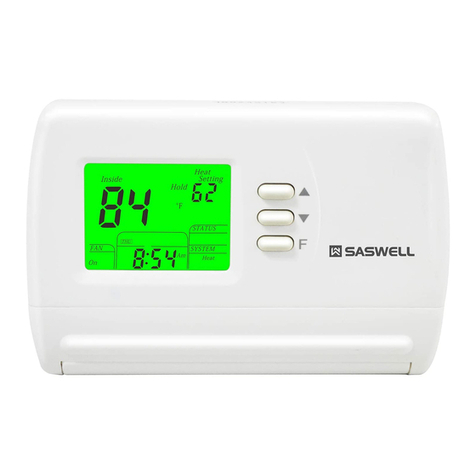
Saswell
Saswell SAS900STK-2 Operating instruction
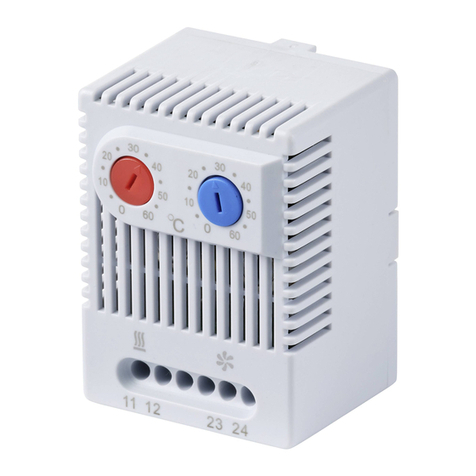
TRU Components
TRU Components TC-ZR011 operating instructions

Uponor
Uponor Climate Control Installation and operation guide
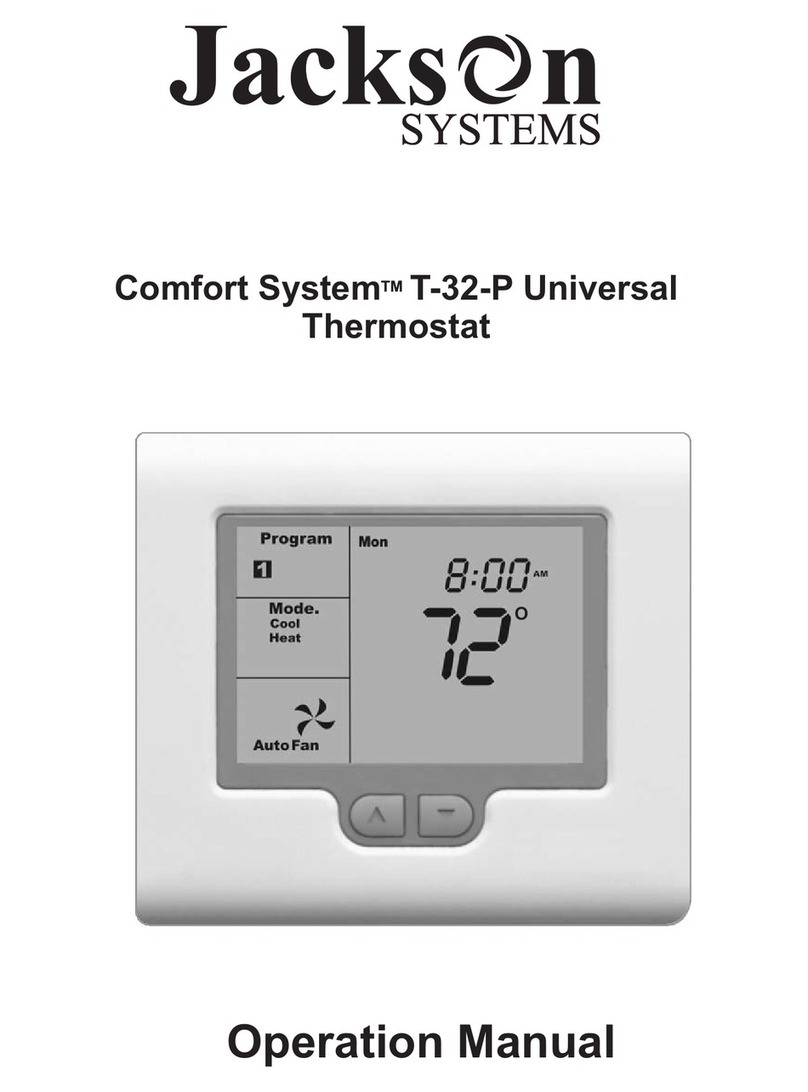
Jackson Systems
Jackson Systems Comfort System T-32-P Operation manual

